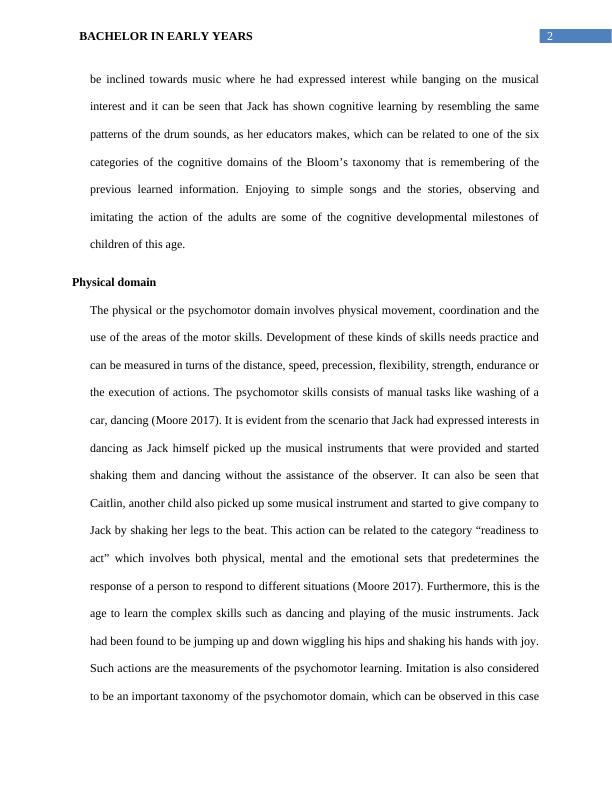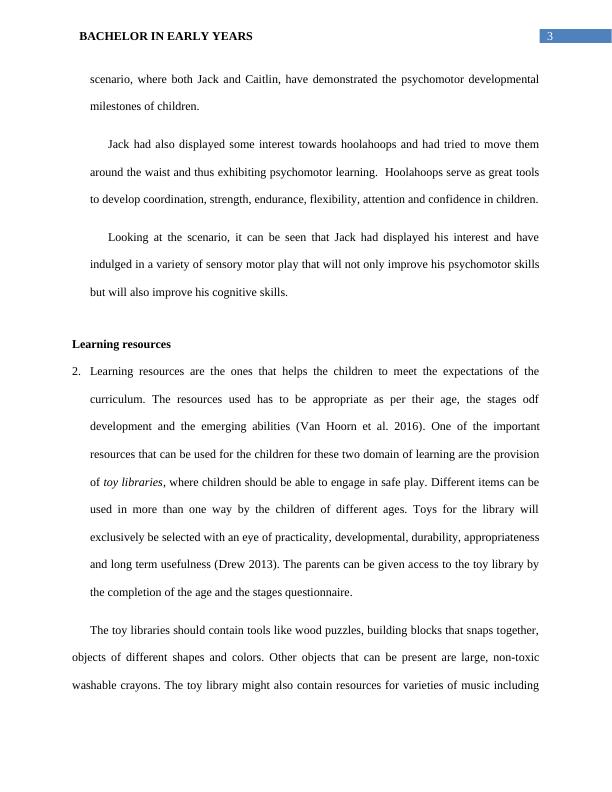More than just play: Developing cognitive and physical skills in early childhood education - Desklib
Added on 2023-05-28
16 Pages3268 Words440 Views
Running head: BACHELOR IN EARLY YEARS
BACHELOR IN EARLY YEARS
Name of the Student
Name of the university
Author’s note
BACHELOR IN EARLY YEARS
Name of the Student
Name of the university
Author’s note

1BACHELOR IN EARLY YEARS
1. Analysis of the domains
Cognitive domain
While considering the development of a child, it is necessary to look at the several domains
of learning or the development areas like cognitive, physical, social, emotional and language of
the children (Van Hoorn et al. 2016). In this report we will consider the main two domains of the
learning- the cognitive domain and the physical domain of the child.
According to bloom’s taxonomy, cognitive domain consists of knowledge and the
development of the intellectual skills (Bloom, 1956), that includes the recognition of the
procedural patterns, specific facts and the concepts serving the development of the intellectual
abilities and the skills. Six major categories are present in the cognitive process which are-
Knowledge, comprehension, application, analysis, synthesis and evaluation. Knowledge is the
ability to recall information or data such as recitation of poems or English alphabets.
Comprehension is the ability of a child to understand the meaning of what is known for example
a teacher discusses a particular theory on her own words (Garvis and Lemon 2015). Application
is the ability of a child to use the already gained knowledge in a completely new situation for
example application of what has been learnt in classes in real life situations. Analysis is the
ability to differentiate between opinions and the facts and the synthesis is the capability to
integrate the different elements or the concepts for forming a sound patterning or structure for
replacing the old schema and forming a new meaning (Gottfried 2013).
The information provided in the case study indicated towards certain cognitive domains of
learning. For example, it is already evident from the case study that Jack had been found to
1. Analysis of the domains
Cognitive domain
While considering the development of a child, it is necessary to look at the several domains
of learning or the development areas like cognitive, physical, social, emotional and language of
the children (Van Hoorn et al. 2016). In this report we will consider the main two domains of the
learning- the cognitive domain and the physical domain of the child.
According to bloom’s taxonomy, cognitive domain consists of knowledge and the
development of the intellectual skills (Bloom, 1956), that includes the recognition of the
procedural patterns, specific facts and the concepts serving the development of the intellectual
abilities and the skills. Six major categories are present in the cognitive process which are-
Knowledge, comprehension, application, analysis, synthesis and evaluation. Knowledge is the
ability to recall information or data such as recitation of poems or English alphabets.
Comprehension is the ability of a child to understand the meaning of what is known for example
a teacher discusses a particular theory on her own words (Garvis and Lemon 2015). Application
is the ability of a child to use the already gained knowledge in a completely new situation for
example application of what has been learnt in classes in real life situations. Analysis is the
ability to differentiate between opinions and the facts and the synthesis is the capability to
integrate the different elements or the concepts for forming a sound patterning or structure for
replacing the old schema and forming a new meaning (Gottfried 2013).
The information provided in the case study indicated towards certain cognitive domains of
learning. For example, it is already evident from the case study that Jack had been found to

2BACHELOR IN EARLY YEARS
be inclined towards music where he had expressed interest while banging on the musical
interest and it can be seen that Jack has shown cognitive learning by resembling the same
patterns of the drum sounds, as her educators makes, which can be related to one of the six
categories of the cognitive domains of the Bloom’s taxonomy that is remembering of the
previous learned information. Enjoying to simple songs and the stories, observing and
imitating the action of the adults are some of the cognitive developmental milestones of
children of this age.
Physical domain
The physical or the psychomotor domain involves physical movement, coordination and the
use of the areas of the motor skills. Development of these kinds of skills needs practice and
can be measured in turns of the distance, speed, precession, flexibility, strength, endurance or
the execution of actions. The psychomotor skills consists of manual tasks like washing of a
car, dancing (Moore 2017). It is evident from the scenario that Jack had expressed interests in
dancing as Jack himself picked up the musical instruments that were provided and started
shaking them and dancing without the assistance of the observer. It can also be seen that
Caitlin, another child also picked up some musical instrument and started to give company to
Jack by shaking her legs to the beat. This action can be related to the category “readiness to
act” which involves both physical, mental and the emotional sets that predetermines the
response of a person to respond to different situations (Moore 2017). Furthermore, this is the
age to learn the complex skills such as dancing and playing of the music instruments. Jack
had been found to be jumping up and down wiggling his hips and shaking his hands with joy.
Such actions are the measurements of the psychomotor learning. Imitation is also considered
to be an important taxonomy of the psychomotor domain, which can be observed in this case
be inclined towards music where he had expressed interest while banging on the musical
interest and it can be seen that Jack has shown cognitive learning by resembling the same
patterns of the drum sounds, as her educators makes, which can be related to one of the six
categories of the cognitive domains of the Bloom’s taxonomy that is remembering of the
previous learned information. Enjoying to simple songs and the stories, observing and
imitating the action of the adults are some of the cognitive developmental milestones of
children of this age.
Physical domain
The physical or the psychomotor domain involves physical movement, coordination and the
use of the areas of the motor skills. Development of these kinds of skills needs practice and
can be measured in turns of the distance, speed, precession, flexibility, strength, endurance or
the execution of actions. The psychomotor skills consists of manual tasks like washing of a
car, dancing (Moore 2017). It is evident from the scenario that Jack had expressed interests in
dancing as Jack himself picked up the musical instruments that were provided and started
shaking them and dancing without the assistance of the observer. It can also be seen that
Caitlin, another child also picked up some musical instrument and started to give company to
Jack by shaking her legs to the beat. This action can be related to the category “readiness to
act” which involves both physical, mental and the emotional sets that predetermines the
response of a person to respond to different situations (Moore 2017). Furthermore, this is the
age to learn the complex skills such as dancing and playing of the music instruments. Jack
had been found to be jumping up and down wiggling his hips and shaking his hands with joy.
Such actions are the measurements of the psychomotor learning. Imitation is also considered
to be an important taxonomy of the psychomotor domain, which can be observed in this case

3BACHELOR IN EARLY YEARS
scenario, where both Jack and Caitlin, have demonstrated the psychomotor developmental
milestones of children.
Jack had also displayed some interest towards hoolahoops and had tried to move them
around the waist and thus exhibiting psychomotor learning. Hoolahoops serve as great tools
to develop coordination, strength, endurance, flexibility, attention and confidence in children.
Looking at the scenario, it can be seen that Jack had displayed his interest and have
indulged in a variety of sensory motor play that will not only improve his psychomotor skills
but will also improve his cognitive skills.
Learning resources
2. Learning resources are the ones that helps the children to meet the expectations of the
curriculum. The resources used has to be appropriate as per their age, the stages odf
development and the emerging abilities (Van Hoorn et al. 2016). One of the important
resources that can be used for the children for these two domain of learning are the provision
of toy libraries, where children should be able to engage in safe play. Different items can be
used in more than one way by the children of different ages. Toys for the library will
exclusively be selected with an eye of practicality, developmental, durability, appropriateness
and long term usefulness (Drew 2013). The parents can be given access to the toy library by
the completion of the age and the stages questionnaire.
The toy libraries should contain tools like wood puzzles, building blocks that snaps together,
objects of different shapes and colors. Other objects that can be present are large, non-toxic
washable crayons. The toy library might also contain resources for varieties of music including
scenario, where both Jack and Caitlin, have demonstrated the psychomotor developmental
milestones of children.
Jack had also displayed some interest towards hoolahoops and had tried to move them
around the waist and thus exhibiting psychomotor learning. Hoolahoops serve as great tools
to develop coordination, strength, endurance, flexibility, attention and confidence in children.
Looking at the scenario, it can be seen that Jack had displayed his interest and have
indulged in a variety of sensory motor play that will not only improve his psychomotor skills
but will also improve his cognitive skills.
Learning resources
2. Learning resources are the ones that helps the children to meet the expectations of the
curriculum. The resources used has to be appropriate as per their age, the stages odf
development and the emerging abilities (Van Hoorn et al. 2016). One of the important
resources that can be used for the children for these two domain of learning are the provision
of toy libraries, where children should be able to engage in safe play. Different items can be
used in more than one way by the children of different ages. Toys for the library will
exclusively be selected with an eye of practicality, developmental, durability, appropriateness
and long term usefulness (Drew 2013). The parents can be given access to the toy library by
the completion of the age and the stages questionnaire.
The toy libraries should contain tools like wood puzzles, building blocks that snaps together,
objects of different shapes and colors. Other objects that can be present are large, non-toxic
washable crayons. The toy library might also contain resources for varieties of music including

End of preview
Want to access all the pages? Upload your documents or become a member.
Related Documents
Learning Theories in Health and Social Carelg...
|10
|788
|230
Benjamin Bloom: Classification of Learning Outcomeslg...
|5
|984
|1
Sex Education: Learning Objectiveslg...
|6
|1098
|64
Blooms Taxonomy and Areas of Knowledge in Health and Social Carelg...
|14
|3635
|436
Educational Design Learninglg...
|4
|761
|216
Stages of Language and Communication Development in Childrenlg...
|10
|2765
|80
